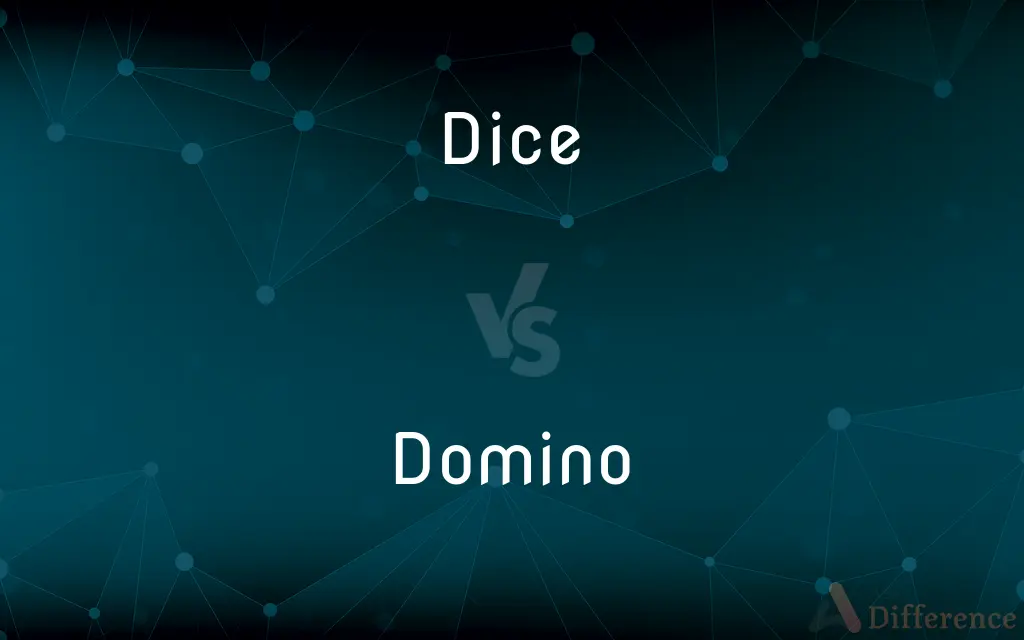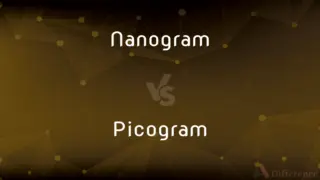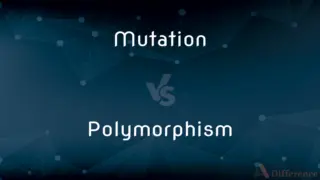Dice vs. Domino — What's the Difference?
By Fiza Rafique & Maham Liaqat — Updated on March 27, 2024
Dice are small, throwable objects with marked sides that determine random outcomes, while dominoes are playing pieces with two divided areas, each showing a number.

Difference Between Dice and Domino
Table of Contents
ADVERTISEMENT
Key Differences
Dice are primarily used in board games, gambling, and randomization tools. They typically have six faces, each marked with dots representing numbers one through six. In contrast, dominoes consist of rectangular tiles divided into two square ends, each end marked with a number of spots or blank, used in a wide range of tile-based games.
Dice are ancient gaming objects, with their usage dating back thousands of years in numerous cultures. They are often associated with chance and luck. Dominoes, on the other hand, have a somewhat clearer historical origin, likely starting in China in the 12th century, and are linked more with strategy and matching skills.
The material composition of dice varies, commonly made from plastic, wood, or bone. This allows for a lightweight, easily throwable object. Dominoes, however, are typically made from wood, plastic, or bone as well, but are crafted to be durable and able to stand upright, necessitating a more substantial material use.
In gameplay, dice are rolled or thrown to generate a random outcome which often determines the movement or action of a player in a game. Conversely, dominoes are played by placing them in a line or other configurations, where matching numbers of dots connect one tile to another, emphasizing strategy over chance.
While dice games are largely individual or competitive in nature, focusing on achieving specific numerical outcomes, domino games can be both competitive and cooperative, involving a deeper level of strategic planning and interaction among players.
ADVERTISEMENT
Comparison Chart
Primary Use
Randomization in games
Playing various tile-based games
Appearance
Cubic with marked sides
Rectangular tiles with two divided areas
Material
Plastic, wood, bone
Wood, plastic, bone
Origin
Ancient, multiple cultures
12th century, China
Gameplay
Rolling to generate outcomes
Matching numbers in a line or configuration
Strategy vs. Chance
Primarily chance-based
Mix of strategy and chance
Number Representation
Dots or numbers for 1 through 6 (or more)
Divided areas with dots or blank
Historical Association
Associated with gambling and luck
Linked with strategy and skill
Game Nature
Individual or competitive
Competitive and cooperative
Compare with Definitions
Dice
A small cube with each side having a different number of dots representing numbers.
He rolled the dice, hoping for a six.
Domino
Rectangular tiles divided into two ends with dots.
He placed the domino on the table, matching the number of dots.
Dice
Used to determine movement in board games.
She threw the dice and moved her piece forward.
Domino
Played in matching and strategy games.
Dominoes require both strategy and luck to win.
Dice
Can be made of various materials.
The wooden dice felt old and worn.
Domino
Can form intricate patterns when lined up.
They set up the dominoes in a complex pattern for a rally.
Dice
Symbol of randomness.
Life is like rolling dice, unpredictable.
Domino
Used in various game types.
They played a game of blocking dominoes last night.
Dice
Associated with games of chance.
Dice are often used in gambling.
Domino
Often made of plastic or wood.
The wooden dominoes had a classic feel.
Dice
Dice (singular die or dice) are small, throwable objects with marked sides that can rest in multiple positions. They are used for generating random numbers, commonly as part of tabletop games, including dice games, board games, role-playing games, and games of chance.
Domino
A small rectangular wood or plastic block, the face of which is divided into halves, each half being blank or marked by dots resembling those on dice.
Dice
Plural of die2.
Domino
Dominoes or dominos (used with a sing. or pl. verb) A game played with a set of these small blocks, generally 28 in number.
Dice
Pl. dice also dices (used with a pl. verb) Small cubes of food.
Domino
A country expected to react politically to events as predicted by the domino theory
"The dominos did indeed fall in Indochina" (Arthur M. Schlesinger, Jr.).
Dice
To play or gamble with dice.
Domino
A costume consisting of a hooded robe worn with an eye mask at a masquerade.
Dice
To win or lose (money) by gambling with dice.
Domino
The mask so worn.
Dice
To cut (food) into small cubes.
Domino
One wearing this costume.
Dice
To decorate with dicelike figures.
Domino
(dominoes) A tile divided into two squares, each having 0 to 6 (or sometimes more) dots or pips (as in dice), used in the game of dominoes.
Dice
(uncountable) Gaming with one or more dice.
Domino
(politics) A country that is expected to react to events in a neighboring country, according to the domino effect.
Dice
A die.
Domino
A masquerade costume consisting of a hooded robe and a mask covering the upper part of the face.
Dice
That which has been diced.
Cut onions, carrots and celery into medium dice.
Domino
The mask itself.
Dice
(intransitive) To play dice.
Domino
The person wearing the costume.
Dice
(transitive) To cut into small cubes.
Domino
(geometry) A polyomino made up of two squares.
Dice
(transitive) To ornament with squares, diamonds, or cubes.
Domino
A mistake in performing.
Dice
To play games with dice.
I . . . diced not above seven times a week.
Domino
(intransitive) To collapse in the manner of dominoes.
Dice
To cut into small cubes; as, to slice and dice carrots.
Domino
(transitive) To cause to collapse in the manner of dominoes.
Dice
To ornament with squares, diamonds, or cubes.
Domino
A kind of hood worn by the canons of a cathedral church; a sort of amice.
Dice
Small cubes with 1 to 6 spots on the faces; used to generate random numbers
Domino
A mourning veil formerly worn by women.
Dice
Cut into cubes;
Cube the cheese
Domino
A kind of mask; particularly, a half mask worn at masquerades, to conceal the upper part of the face. Dominos were formerly worn by ladies in traveling.
Dice
Play dice
Domino
A costume worn as a disguise at masquerades, consisting of a robe with a hood adjustable at pleasure.
Domino
A person wearing a domino.
Domino
A game played by two or more persons, with twenty-eight pieces of wood, bone, or ivory, of a flat, oblong shape, plain at the back, but on the face divided by a line in the middle, and either left blank or variously dotted after the manner of dice. The game is played by matching the spots or the blank of an unmatched half of a domino already played
Domino
One of the pieces with which the game of dominoes is played.
Domino
United States rhythm and blues pianist and singer and composer (born in 1928)
Domino
A loose hooded cloak worn with a half mask as part of a masquerade costume
Domino
A mask covering the upper part of the face but with holes for the eyes
Domino
A small rectangular block used in playing the game of dominoes; the face of each block has two equal areas that can bear 0 to 6 dots
Common Curiosities
Can dominoes be used for decoration?
Yes, dominoes can be arranged in patterns for decorative purposes or domino rallies.
Are dice games based solely on luck?
While many dice games rely heavily on luck, some also incorporate strategic elements.
What are dice made from?
Dice can be made from plastic, wood, or bone.
How are domino games won?
Domino games are typically won by matching tiles strategically, blocking opponents, or achieving certain configurations.
What is the primary use of dominoes?
Dominoes are used for playing various tile-based games.
Can dice have more than six faces?
Yes, there are dice with more than six faces, used in various games and contexts.
Do dominoes always have numbers on them?
Dominoes typically have a number of spots, but some sets use blank or specialized symbols.
How many sides does a standard die have?
A standard die has six sides.
Are there different types of dice games?
Yes, there are many types of dice games, including gambling, strategy, and board games.
How do you play dominoes?
Players take turns placing dominoes with matching numbers adjacent to each other.
What historical period do dominoes originate from?
Dominoes likely originated in China during the 12th century.
What's the significance of the material of dominoes?
The material affects the durability, feel, and aesthetic appeal of dominoes.
Is there a limit to the number of players in domino games?
While most domino games are designed for 2 to 4 players, variations can accommodate more.
What skills can be developed by playing dice and domino games?
Playing these games can develop mathematical, strategic thinking, and social interaction skills.
Can dice be used in educational settings?
Yes, dice are used in educational games to teach mathematics and probability.
Share Your Discovery

Previous Comparison
Nanogram vs. Picogram
Next Comparison
Mutation vs. PolymorphismAuthor Spotlight
Written by
Fiza RafiqueFiza Rafique is a skilled content writer at AskDifference.com, where she meticulously refines and enhances written pieces. Drawing from her vast editorial expertise, Fiza ensures clarity, accuracy, and precision in every article. Passionate about language, she continually seeks to elevate the quality of content for readers worldwide.
Co-written by
Maham Liaqat















































